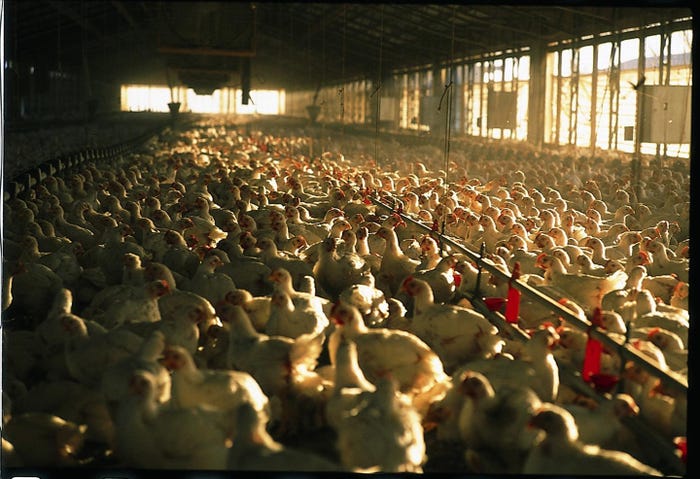Poultry industry grapples with marketing terminology
Experts, veterinarians and Sanderson Farms weigh in on antibiotics in poultry production.
February 9, 2016

"Natural," "organic," "hormone free," "pesticide free," "non-GMO" — These are just a few of the terms consumers encounter when purchasing meat at the grocery store. While some argue that these labeling terms describe the products, others have argued that the terms are meaningless and part of a marketing ploy to drive sales and increase prices.
Now, consumers are being confronted by the latest labeling additions: "antibiotic free," "raised without antibiotics" and "no antibiotics." What's the real story behind this growing trend?

Source: Sanderson Farms.
Since the 1950s, the Food & Drug Administration has banned all antibiotic residues in finished food products, including meat. By law, every food product technically must be free of antibiotic residue. Animal producers must comply with withdrawal times — the time it takes for antibiotics to work their way out of an animal's system before the animal is allowed to enter the food supply chain.
So, in light of the law, why is there a sudden push by private organizations and some consumers to ban animal antibiotic use altogether?
One answer may be that some consumers think using antibiotics to treat animals results in antibiotic residue in the finished food product.
According to Dr. Chuck Hofacre, director of clinical services for the University of Georgia's College of Veterinary Medicine, "All meat and poultry are truly antibiotic free; however, with residue, the misconception is that when you eat meat from animals treated with antibiotics, you are eating what they ate, which is simply not true."
Another answer may be attributed to the emergence of new food labels affecting consumers' perceptions. Dr. Yvonne Thaxton, professor and director of the Center for Food Animal Wellbeing at the University of Arkansas, explained, "It's confounding that companies are labeling chicken as 'antibiotic-free' or 'no antibiotics,' which leads to the impression that other chicken has antibiotics. It's a marketing strategy, not necessarily the truth. You don't find that with beef or pork — at least not yet."
In the past, the U.S. Department of Agriculture recognized the potential for consumer confusion with product labeling. Growth hormone use, for example, has been illegal in poultry production for more than 50 years, but when some producers began requesting approval to label their products as "hormone free" or containing "no added hormones," USDA implemented a requirement that the claims could not be used to market poultry unless they were followed by a disclaimer: "Federal regulations prohibit the use of hormones in poultry."
The hormone debate is analogous to the latest antibiotic concerns in which some consumers have a fear of ingesting antibiotic residues, just as they feared ingesting hormones, despite the fact that residue from either has been illegal for some time. On the other hand, some consumers are less concerned with ingesting antibiotics but more concerned about antibiotic resistance — a wholly separate topic.
According to Charlie Arnot, chief executive officer of The Center for Food Integrity, antibiotic resistance "is a complex question to answer. However, the answer lies in knowing the difference between residue and resistance. The assumption is that they are the same. Resistance, however, is a completely separate issue and refers to organisms adapting to their environment and building up resistance."
Arnot continued, "Resistance does not mean you are eating antibiotics when eating animal protein; this is more about foodborne illness. For example, if we give antibiotics to chickens and they develop a hardier form of salmonella-resistant bacteria and you don't cook your meat all the way, you will get that hardier form of salmonella. However, that's not necessarily the case."
~~~PAGE_BREAK_HERE~~~
Bacterial resistance touches on another concern regarding the use of antibiotics in poultry production and the rise of "superbugs." This alarming informal term is usually associated with human-borne, antibiotic-resistant bacteria, but recently it has entered into the discussion on antibiotic use in poultry production. Even FDA has taken issue with it, stating: "It is inaccurate and alarmist to define bacteria resistant to one, or even a few, antibiotics as 'superbugs' if these same bacteria are still treatable by other commonly used antibiotics."
Dr. Sacit F. Bilgili, professor emeritus and extension specialist of poultry science for Auburn University, explained, "Concerns about resistant bacteria are legitimate, and like many other inquiries on agriculture practices in general, we must educate and inform the public on how food is produced and the regulatory oversights in place to reduce risk to consumers."
While the inquiry may be laudable, there hasn't been conclusive proof of poultry-borne superbugs. "To my knowledge, there isn't a superbug that has been identified from poultry consumption or antibiotics used in poultry," Arnot said. "Most are from institutions — hospitals, nursing homes, etc."
Weighing in on both the residue and resistance issues, Dr. Phil Stayer, corporate veterinarian for Sanderson Farms, explained, "The process chain between a food animal and a person (consumer) is very long. Animals are raised on farms, and the antibiotics are withdrawn long before processing. As feathers and viscera are removed, the majority of bacteria is also removed. The edible product is placed into meat packages that then go through a cold chain, where most bacteria have difficulty surviving. Following the cold chain, the product goes through a hard chilling system or freezer chain and is then sold, cooked and consumed. So, it is unlikely that bacteria that starts on a farm makes it all the way to the consumer. It could happen, but it would have to survive a very long process chain."
Over the last 50 years, the practice of raising chicken commercially has changed dramatically. Technology has improved, making the process more efficient in order to meet the demands of a growing population. This has raised questions regarding the current practice of raising commercially grown chickens.
Dr. Leah C. Dorman, director of food integrity and consumer engagement at Phibro Animal Health, weighed in on the issues and benefits surrounding current poultry production. "From a sustainability standpoint, antibiotics help keep flocks healthy, which means less water, feed and land needed, which leads to a decreased carbon footprint. Of course, for those of us passionate about animal health, the fact that antibiotics help to prevent animal suffering is key.
"When it comes to food safety, reducing the amount of bacteria in birds naturally also reduces the amount of bacteria entering the food supply," Dorman added. "Our food is safer than ever before because we are continually learning and improving practices and processes. There are teams of people dedicated to caring for flocks on farms, including nutritionists, veterinarians and specialists. It's all very progressive and it's a good thing for both bird health and public health."
Dr. Karen Burns Grogan, a consulting poultry veterinarian and executive vice president of the American College of Poultry Veterinarians, described the difficult position people in her profession face, explaining, "As veterinarians, we are passionate about what we do. When misinformation like this occurs and the tools we use to prevent animal suffering are taken away from us, it's very disheartening. It means animals are suffering from something I know I could treat responsibly."
Grogan continued, "I am a veterinarian, I'm a mom and I'm a consumer, too, and I buy conventionally raised chickens because I know that they follow strict withdrawal times and best management practices to provide a safe product for my family to eat."
For industry experts and producers, animal welfare is not the only priority; consumer safety is also of the utmost importance. "Consumer safety is number one," Stayer said. "We are not going to do anything to endanger our consumers, which happen to be our families as well."
Dorman echoed this sentiment, saying, "There are multiple safeguards in place to make sure the chicken we feed our families is safe, wholesome and free of any unsafe residue. When meat is labeled 'antibiotic-free,' it simply means that the animal was raised without the benefit of antibiotics. I am concerned that some animals are left to suffer when they get sick in situations where antibiotics have been taken away as a tool for ethical animal care."
Dorman added, "As a mother, farmer and vet, I love the fact that there are so many choices at the grocery store, and if it makes you feel better to get antibiotic-free meat, then I think that's great. However, sometimes those choices have unintended consequences, and that's what worries me — the care of the animals.
"As veterinarians, we take an oath to protect animal health, promote human health and prevent animal suffering. I wholeheartedly support consumer choice; I just want to ensure consumers have the chance to make informed choices. In my view, it's about finding a responsible balance," Dorman said.
SOURCE: Sanderson Farms.
You May Also Like


.png?width=300&auto=webp&quality=80&disable=upscale)
